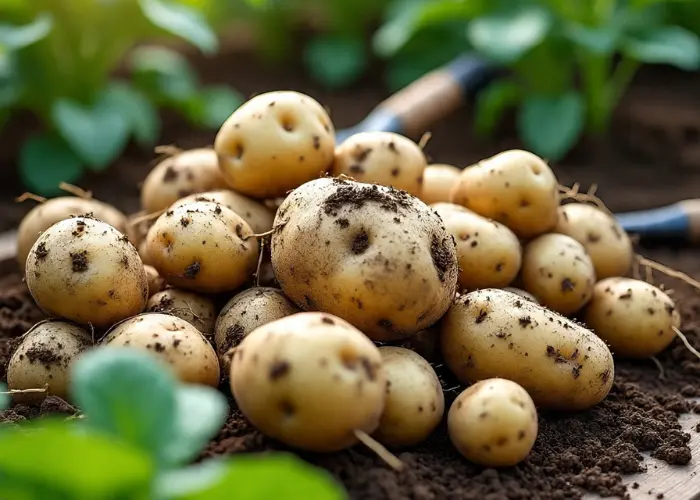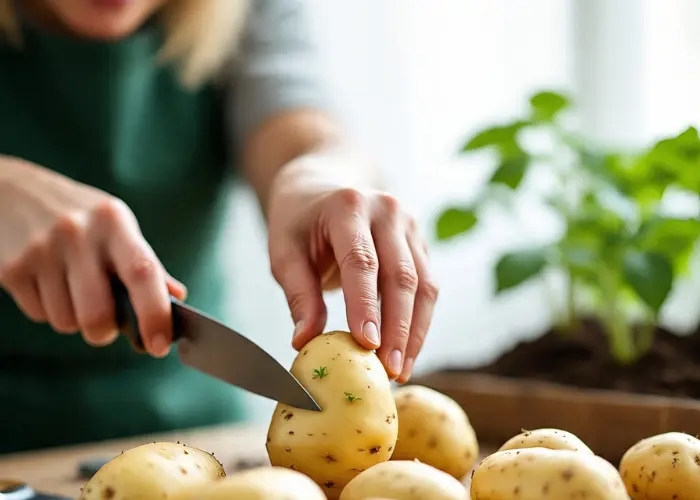How to Grow Potatoes: The Ultimate Guide for Beginners

If you’ve ever dreamed of growing yourself a food source, then there aren’t many plants as satisfying as potatoes. They’re not only delicious and versatile, they’re also extremely easy to cultivate even for novices. If you’re growing them in your backyard or in a container for the smallest of spaces gardening with potatoes provides practical and emotional benefits. Plus they’re loads of fun to pick!
This article will go over the fundamentals of cultivating potatoes, from selecting the best seed potatoes to understanding the importance of soil preparation. The process will be broken down into manageable steps and provide strategies to ensure a successful harvest. If you’re interested to plant the potatoes you want to grow, then let’s begin!
The Basics of Growing Potatoes
Potatoes, scientifically called Solanum tuberosum are a robust plant that is able to be grown in all climates, although they prefer cooler climates. They’re grown as cool season annuals in many regions but thrive all year round in areas with no frost. If you’re in a temperate zone, you’re in luck! The potato can thrive in areas with cold temperatures from early spring to cool summer temperatures. For those living in warmer climates don’t fret, you can still cultivate potatoes even in cooler weather.
Choosing Your Potato Variety
There are a variety of potatoes available Each possessing its own distinctive features. Some of the most well-known varieties are Yukon Gold, Russet, and Fingerling. Each variety differs in taste and texture as well as size, so it’s crucial to select one that is suitable for your preferences. Yukon Gold is fantastic for creamy potatoes, and Russet is ideal for frying or baking. If you’re looking to do things that are a bit more adventurous, fingerling potatoes add a distinct rich and savory flavor to roasts and salads.
Preparing to Grow Potatoes: Soil, Sun, and Water
Before you begin planting we’ll discuss the things that potatoes require to flourish. The tubers in the ground are sensitive to the environment they live in However, don’t let that put you off. With just a few steps you can make sure your potatoes will grow robust and healthy.
Soil
Potatoes require a loose, well-drained, fertile soil. They thrive in soil with an acidity range of 5.8 up to 6.5. When your soil’s pH range is acidic or alkaline, it could be difficult for plants to development or the production of potatoes. The addition of fertilizer to your soil can help improve its structure and supply the nutrients slowly released. Remember that potatoes require ample space to develop their tubers and therefore, ensure that your soil isn’t overly compacted.
- Tips A tip: If your soil is too clayey or heavy You may want to add organic matter or sand to loosen it. A good soil is the key to a successful growth of potatoes.
Sunlight and Water
Potatoes require at minimum 6-8 hours of sun each day. If the conditions are right they thrive in full sunlight. Be sure to select an area with sun in your yard where your plants will not be shadowed by other plants or structures. daily watering is essential to the growth of your plants. Try to get about 1-inch of water each week. Try not to make sure that your soil stays moist but not too wet.
- Tips : When you’re cultivating potatoes in containers, you’ll need to water them more often than if you were grown in the soil.
Planting Your Potatoes: Step by Step
The process of growing potatoes begins with the proper planting method. Let’s take it step-by-step.
Step 1: Choose Seed Potatoes

In first step you’ll need is seeds of potatoes. It’s crucial to select certified seed potatoes instead of the ones you buy at the grocery store. Potatoes purchased from stores are typically processed with pesticides that hinder sprouting and can carry disease. In Certified seed potatoes are free of disease and specifically selected to grow.
Step 2: Prepare and Cut Your Seed Potatoes
Cut the seed potatoes into pieces. Each piece should be equipped with at minimum two eyes (the tiny indentation from which new shoots will emerge). Allow the pieces to rest for between 24 and 48 hours in order for the surfaces of the cut to harden over. This will prevent the rotting process after they’ve been buried.
Step 3: When and How to Plant
The seed potatoes are planted in the spring once the risk of frost is over. Ideally, you would like the temperature of the soil at or below 45degF (7degC). Dig holes between 4 and 6 inches deep, and space the seeds between 12 and 15 inches. Plant the cut sides in the direction of the downwards and plant them in soil. If you don’t want to hill your potatoes, plant them between 8 and 9 inches deep, to eliminate the need for additional levels of soil.
Step 4: Hill Around the Plants
As soon as your plants begin to grow and gaining height, it’s the time to raise them. Place soil on the bottom of the plants to shield growing tubers and to promote healthy growth. Hilling prevents the potatoes from turning green (which could cause them to become poisonous) and increases the overall yield.
Taking Care of Your Potato Plants
Once your potatoes are being planted in your garden, learn how you can ensure they stay healthy and happy throughout the growth season.
Mulching and Fertilizing
Mulching can help retain the moisture and prevents the growth of weeds. Utilize straw, shredded leaves or even compost, to protect the roots of the plant. For fertilization, potatoes require an organic fertilizer with low nitrogen and high phosphorus to promote the growth of strong roots and tubers. Side-dressing with compost is a good option during the midseason when your plants appear weak or pale. Make sure to not overdo it as excessive nitrogen could cause greater foliage growth than the tubers.
Watering and Pest Control
It is essential to water regularly particularly when the plants begin flowering and tubers begin to grow. Keep the soil moist, but not too wet. Potatoes are susceptible to aphids, pests such as the Colorado potato beetle as well as Aphids, so you need to be on guard. The rotation of your crop is crucial to prevent diseases such as late and early blight that can destroy your crops if they are not controlled effectively.
Harvesting Your Potatoes: The Fun Part
when the leaves of the plant start to die back.You can harvest potatoes. It usually happens between 70 to 120 days following planting, based on the kind of potato. You could pick your potatoes earlier to harvest smaller new potatoes or wait until the plants are mature enough to harvest full-sized tubers.
How to Harvest
When you are ready to harvest the potatoes, lightly sift the soil around the potato plants. Utilize a garden fork, or a shovel, but be careful not to scratch the tubers. Clean any soil that is left and keep your potatoes in a dark, cool area. Let them cure for a few weeks before eating them or storing them for the long-term.
Storing Your Potatoes
Following harvest, the potatoes require to be stored in a proper manner to avoid the loss of their nutrients. Place them in an air-conditioned dry, dark place with a good air circulation. Basements or cellars are the best for storage, but provided you find an area that is suitable for these conditions the potatoes can last for months.
Troubleshooting Common Potato Problems
Even with the best treatment, potatoes are susceptible to certain difficulties. Here are some of the most common mistakes and tips to prevent them
- If you don’t hill enough, exposed potatoes develop a green color and then become unpalatable. Make sure you protect your tubers by covering them in enough dirt or mulch.
- Insufficient watering can cause the tubers to turn brown particularly in soils with heavy clay. Be sure that the soil is adequately drained and stay clear of excessive watering.
- If you plant too early, the soil is damp and cold it may cause seeds potatoes to turn brown. It is best to wait until the soil is been warmed up.
